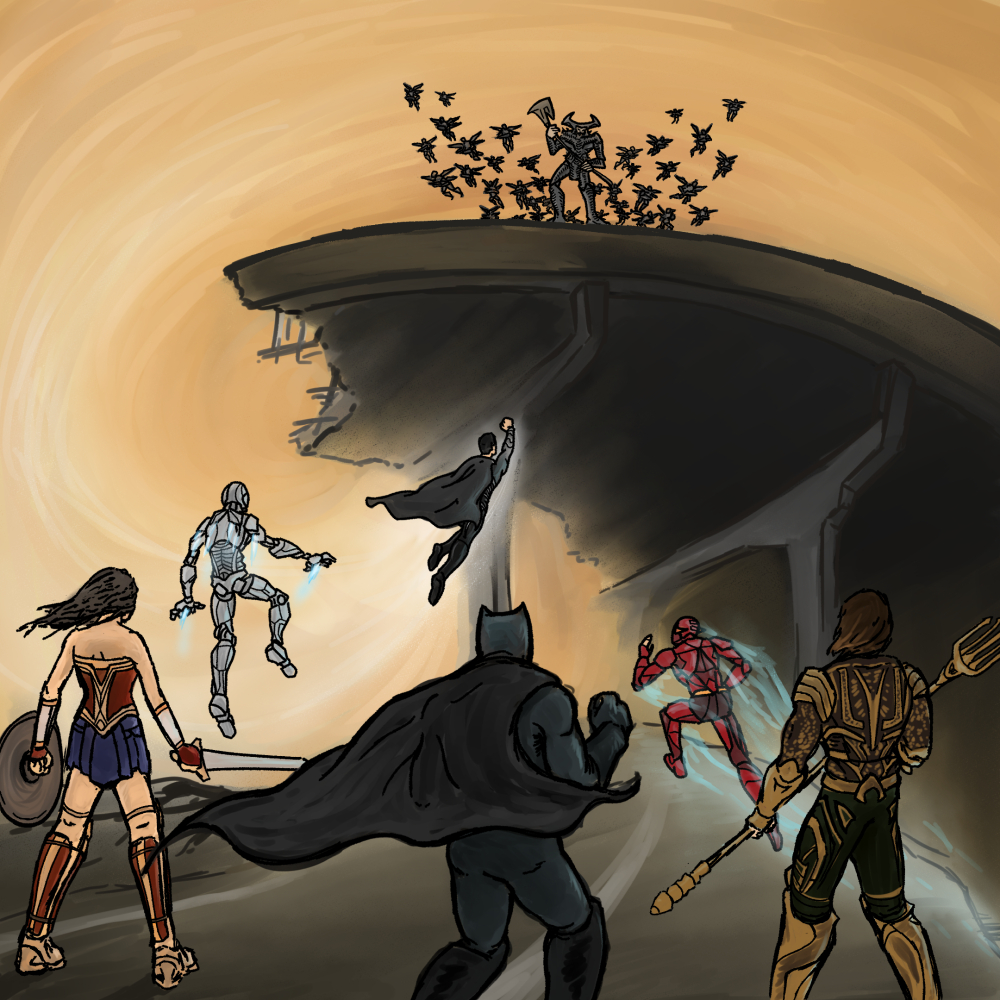Please visit response.fsu.edu for official FSU updates and resources.
Did DC Films Redeem Justice League with the Snyder Cut?
 When I first heard that Zack Snyder would be getting a second chance at directing Justice League, I was hesitant, but I was also looking forward to seeing what the new version of the film would deliver. I, like many other fans, found the original 2017 theatrical release to be extremely underwhelming. DC films have been very inconsistent with multiple productions failing to live up to their potential, especially Suicide Squad and Batman vs. Superman. However, there have been some releases that I enjoyed, like Wonder Woman, Joker, and Birds of Prey. These gave me hope for Zack Snyder's Justice League. Snyder was given freedom to use deleted footage and shoot new scenes, along with a $300 million budget. And with a four-hour run time, Snyder leaves no stone unturned in making sure the story is told exactly the way he had originally envisioned. Now the question is, did it live up to the hype? Is it really that much better? Did DC fans finally get the movie they deserved?
When I first heard that Zack Snyder would be getting a second chance at directing Justice League, I was hesitant, but I was also looking forward to seeing what the new version of the film would deliver. I, like many other fans, found the original 2017 theatrical release to be extremely underwhelming. DC films have been very inconsistent with multiple productions failing to live up to their potential, especially Suicide Squad and Batman vs. Superman. However, there have been some releases that I enjoyed, like Wonder Woman, Joker, and Birds of Prey. These gave me hope for Zack Snyder's Justice League. Snyder was given freedom to use deleted footage and shoot new scenes, along with a $300 million budget. And with a four-hour run time, Snyder leaves no stone unturned in making sure the story is told exactly the way he had originally envisioned. Now the question is, did it live up to the hype? Is it really that much better? Did DC fans finally get the movie they deserved?
From this point forward I warn you that there are multiple spoilers, so if you have not seen Zack Snyder’s cut and are planning to, please go watch it and come back.
I had many problems with Joss Whedon’s 2017 Justice League, many of which are shared across the DC fandom. My main issue with the film was that it tried to copy the MCU formula for light-hearted and comedic superhero movies as opposed to trying to do its own thing (which is reflected in much of the writing, unnecessary scenes, and its PG-13 rating). I also felt as though the movie offered little in terms of character development for new heroes such as Flash, Cyborg, and Aquaman, and did little to expand on ones that have already been established. Not to mention the fact the plot was extremely weak and the main villain, Steppenwolf, was one of the worst villain portrayals I think that I have seen in a modern superhero movie. All of these are things that I felt Snyder had to address if the film had any chance of being salvaged.
When it comes to character development, I think that is one of the areas that Snyder’s version improves upon the most. With two extra hours of screen-time, proper introductions, backgrounds, development, and individual moments for every member of the Justice League are put in place. Barry Allen (Flash) and Victor Stone (Cyborg) are the two that benefitted the most. Snyder established proper backstories for both young heroes, including their struggles to find their place in the world before being approached to join the League. Barry Allen is introduced as a light-hearted, unemployed 25-year-old trying to fund a community college degree in Criminal Justice to help his father, wrongfully convicted for murdering Barry’s mother, get out of jail. An amazing deleted scene has been added where Allen uses his powers to save future love-interest, Iris West, from a potentially fatal car crash outside of a pet store. Allen is still the comic relief of the film but is given much more depth and many important contributions, especially towards the end when he travels faster than the speed of light to give Cyborg the necessary energy to separate the Motherboxes.
Victor Stone (Cyborg) is equally improved as we see more of his tragic backstory, damaged relationship with his father, and struggle to deal with his new body, abilities, and life after being saved from the fatal car accident that killed his mother. His father, Dr. Stone, uses alien technology (Motherbox) to save his life but ends up transforming him into a half-human mechanical being. Snyder revealed that Victor is the “heart of the film” because of his individual growth from being unsure of his purpose in life to eventually accepting his role as a hero and in the League. This was a big relief for many, like myself, who found the 2017 version of Cyborg to be pretty bland and one-dimensional. There’s a great improvement in the established heroes, like Aquaman, who receives more screen time, dialogue, and background information that explains why he holds so much resentment towards the people of Atlantis. Wonder Woman and Batman are given clearer motives, more important contributions, greater personal development, and take on important leadership roles. Superman’s resurrection is given a longer, more realistic and emotional transition from initially fighting the League to remembering who he is (thanks to Lois Lane and his mother) to eventually helping the league defeat Steppenwolf.
In terms of cinematography, while not every moment was perfect, the actual production of the film is significantly better in Snyder’s cut. Throughout the film, there is repeated use of desaturated color pallets, unique camera angles, extended fight scenes, and signature slow-motion shots. None of which will be a surprise for anyone familiar with Snyder’s work. Whether you're a huge fan of Snyder’s style or not, you will appreciate the effort and many improvements that went into the production of this version of the film. The film is presented in a 4:3 format as opposed to widescreen because Snyder felt it would enhance the viewing experience. It’s also split into six “chapters” that divide the movie into individual narrative arcs that build on one another. While some may think these changes are unnecessary, I feel like they add a unique touch to the film.
The new soundtrack is fantastic, with composer Junkie XL returning and adding multiple new scores which fit in superbly (especially the one that plays before some of the bigger fights). The CGI is greatly improved across the board, including fight scenes, world-building, and Steppenwolf’s costume and facial expressions, which are far more impressive. Many of the new/extended fight scenes are simply outstanding, some of my favorites included the war between Darkseid and the defenders of the earth, the league teaming up to defeat Steppenwolf, and newly resurrected Superman completely wiping the floor with every member of the League with minimal effort.
The aspect of the 2017 film that I felt would be the most important to fix was the weak plot and structural issues. I was very pleased that this was one of the areas that most differentiates the two versions of Justice League. The beginning and end are completely different and change the entire narrative of the film. In Snyder’s cut, we are properly introduced to Darkseid, the evil ruler that Steppenwolf served under until he was castaway for betrayal. Earth is the only world that Darkseid had ever failed to conquer when he was defeated by its defenders (comprised of Mankind, Gods, Atlantians, Amazonians, and a Green Lantern warrior) thousands of years ago. He has been searching for it ever since because earth contains the Anti-life equation, which would allow him to conquer the entire universe and turn all of its inhabitants into mindless servants. In this version of the film, Steppenwolf’s desire to conquer Earth stems from wanting to redeem himself and regain the trust of his former leader. This explains why he is so desperate to conquer Earth, and the added dialogue between Steppenwolf and members of the League also adds a lot to the tension between the two sides as they both race to their goals, in preparation for Darkseid’s arrival.
The ending is also totally changed by an added montage of each member's lives after saving the world from Steppenwolf. Victor finds peace with his father, Barry’s father being proud of him for moving on and getting a “real job”, and Aquaman starts to become more accepting of his Atlantean heritage. After this, we see two important cliffhanger epilogue scenes, the first being a conversation between Lex Luthor and Deathstroke as they discuss future plans and Batman. In the second, we see an apocalyptic premonition that Bruce Wayne experiences in a dream sequence similar to one he experienced during Batman vs Superman. We see members of the league and others in a desert-like chaos discussing the dire state of the world; we also see the highly-anticipated return of Jared Leto’s Joker who shares an intense dialogue with Batman. He reveals that it is Batman’s fault that the world has descended into chaos because he is responsible for the death of Lois Lane, which ultimately led to Superman joining Darkseid. This short scene was better than the entirety of Leto’s Joker performance in Suicide Squad and was actually really enjoyable. When Bruce wakes up, he is visited by Martian Man-Hunter who shows his admiration for the league and their efforts to save the world. The reason these plot changes make Snyder’s cut so much better is not only that it makes Justice League more sensical, enjoyable, and cohesive, but it makes the entire DCEU more enjoyable as a result. They help explain many moments from other DC films, like Batman vs Superman, while also setting up future DC films to pick up where this Justice League ends.
From the beginning, it was obvious that Snyder’s cut of Justice League would probably be better than the 2017 version, the question was whether or not the film would give DC fans the live-action cinematic experience worth watching, given the original had so many shortcomings. Even with all of the concerns I had before watching the film, I can confidently say that Zack Snyder's Justice League is not only a massive improvement on the original but an overall amazing viewing experience. The added character development, cinematic production, new footage, and plot adjustments all contributed to a Justice League that DC Studios and fans can be proud of. It sounds crazy that a four-hour-long movie left me wanting more, but it did, in a good way. This movie gives me hope for DC films moving forward. It is well worth the time for any DC fan who was let down by the 2017 version and is willing to give it another chance, or new fans who want to experience some of the best DC live-action cinema that has been released to date.
Written by: Bryan Herrera | Instagram
Art by: Yanni Spanolios | Instagram



